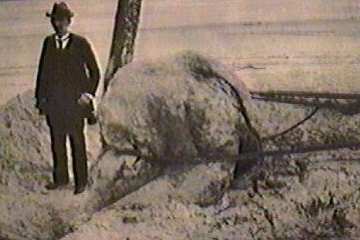pop up description layer
HOME
Cryptozoology UFO Mysteries Aviation Space & Time Dinosaurs Geology Archaeology Exploration 7 Wonders Surprising Science Troubled History Library Laboratory Attic Theater Store Index/Site Map Cyclorama
Search the Site: |
|
The Colossal Octopus Known varieties of octopus range in size from a circumference of a few inches to as large as 23 feet. There is some evidence that, deep in the sea, there lives an unknown species of octopus that can grow to over a hundred feet across and weigh 10 tons. The octopus is a distant cousin of the squid and both belong to a group of animals called cephalopods. Both are invertebrates, that is they have no backbone, and each have multiple arms, lined with suckers, that allow the creatures to hold fast to prey or other objects. Both are fairly intelligent, with large dark eyes. Both are carnivorous. Squid have ten appendages (two tentacles and ten arms), though, while the octopus has only eight. Squid are also thought to spend most of their time in the mid-waters while the octopus is a bottom dweller using it's arms to move from rock to rock. Finally, while the squid has a reputation for aggression, the octopus has a more shy and retiring disposition. Not that octopi are entirely harmless. When angered they can be dangerous to both swimmers and divers. With their strong, long arms they can hold a man underwater until he drowns. The giant squid is a known creature and they have been seen at sea. Several dead, or nearly dead, animals have been found in the shallows or beached. In contrast only one colossal octopus carcass has ever been found and it was, and still is, surrounded in controversy. The story starts in November of 1896 when two boys cycling along the beach south of St. Augustine, Florida, came across the body of an enormous creature that had been washed up by the tide. Dr. DeWitt Webb, a local amateur naturalist and President of the St. Augustine Historical Society, took an interest in the remains. After an examination of the mutilated and decaying body he believed that he'd discovered the carcass of a huge octopus. The portion of the creature that remained, the body minus the arms, was eighteen feet in length and ten feet wide. Parts of arms, unattached to the body, stretched as long as 36 feet with a diameter of 10 inches. Dr. Webb estimated weight at four or five tons. Realizing this was an important find Webb wrote to Yale Professor Addison Verrill, a leading expert on cephalopods, about the creature: "You may be interested to know of the body of an immense Octopus thrown ashore some miles south of this city. Nothing but the stump of the arm remains, as it had evidently been dead for some time before washed ashore." Based on photographs sent by Webb, Verrill concluded that the creature was indeed a colossal octopus that might have had a diameter of one-hundred and fifty feet when living. Strangely enough, despite the importance of the find, Dr. Verrill, nor any other scientist, traveled to St. Augustine to view the carcass in person. Webb finally sent Verrill a sample of the tissue of the creature preserved in formalin. Verrill was surprised to find it had the appearance of blubber and abruptly changed his mind stating that he now believed the creature was a whale and that the arms were not associated with the body. The whole matter would have rested like that if it hadn't been for Forrest Wood, the director of Marine Studios (later Marineland) in Florida. Wood came across an old news story about the monster and discovered that Webb's sample was still stored at the Smithsonian Institution. Wood persuaded the Smithsonian to let Dr. Joseph Gennaro, of the University of Florida, to take some of the samples for analysis. Gennaro immediately recognized that the material was not blubber and examination under a microscope showed the tissue was more similar to octopus than whale or squid. Further tests later confirmed this conclusion. So it seems that Webb was right and Verrill changed his mind too quickly - maybe. The
scientific community has not yet accepted Gennaro's conclusions, though a later an analysis by Roy P. Mackal, a biologist with the University of Chicago, agreed that the material was "not blubber," but consistent with a cephalopod (octopus or squid). In 1995, four scientists set out to take another look at samples of the St. Augustine carcass. Their results, published in the Biological Bulletin, disputes the other findings. These researchers looked at the amino acids in the remains and reached the conclusion they did not come from a invertebrate. They concluded the material was most likely the remains of a whale skin. Other writers and scientists have disputed these findings noticing that it would be extremely difficult to removed the skin from a whale, intact, and get it to solidify into a three-foot-thick sold mass as was observed on the beach at St. Augustine. How come more colossal octopi haven't been found? Speculation is that as a bottom dweller the colossal octopus bodies, upon death, stay on the bottom and decay leaving few clues for scientists to find. Perhaps as we start to explore the bottom of the sea further we may come face to face with a colossal octopus and look into his huge unblinking eyes. Copyright Lee Krystek 1996. All Rights Reserved
|
|
Related Links |
|
|





